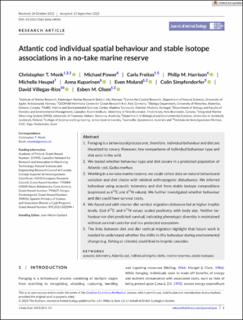| dc.contributor.author | Monk, Christopher | |
| dc.contributor.author | Power, Michael | |
| dc.contributor.author | Freitas, Carla | |
| dc.contributor.author | Harrison, Philip M. | |
| dc.contributor.author | Heupel, Michelle | |
| dc.contributor.author | Kuparinen, Anna | |
| dc.contributor.author | Moland, Even | |
| dc.contributor.author | Simpfendorfer, Colin | |
| dc.contributor.author | Villegas-Ríos, David | |
| dc.contributor.author | Olsen, Esben Moland | |
| dc.date.accessioned | 2023-11-08T09:13:29Z | |
| dc.date.available | 2023-11-08T09:13:29Z | |
| dc.date.created | 2023-10-31T13:05:58Z | |
| dc.date.issued | 2023 | |
| dc.identifier.citation | Journal of Animal Ecology. 2023, . | |
| dc.identifier.issn | 0021-8790 | |
| dc.identifier.uri | https://hdl.handle.net/11250/3101311 | |
| dc.description.abstract | Foraging is a behavioural process and, therefore, individual behaviour and diet are theorized to covary. However, few comparisons of individual behaviour type and diet exist in the wild. We tested whether behaviour type and diet covary in a protected population of Atlantic cod, Gadus morhua. Working in a no-take marine reserve, we could collect data on natural behavioural variation and diet choice with minimal anthropogenic disturbance. We inferred behaviour using acoustic telemetry and diet from stable isotope compositions (expressed as δ13C and δ15N values). We further investigated whether behaviour and diet could have survival costs. We found cod with shorter diel vertical migration distances fed at higher trophic levels. Cod δ13C and δ15N values scaled positively with body size. Neither behaviour nor diet predicted survival, indicating phenotypic diversity is maintained without survival costs for cod in a protected ecosystem. The links between diet and diel vertical migration highlight that future work is needed to understand whether the shifts in this behaviour during environmental change (e.g. fishing or climate), could lead to trophic cascades. | |
| dc.language.iso | eng | |
| dc.title | Atlantic cod individual spatial behaviour and stable isotope associations in a no-take marine reserve | |
| dc.title.alternative | Atlantic cod individual spatial behaviour and stable isotope associations in a no-take marine reserve | |
| dc.type | Peer reviewed | |
| dc.type | Journal article | |
| dc.description.version | publishedVersion | |
| dc.source.pagenumber | 15 | |
| dc.source.journal | Journal of Animal Ecology | |
| dc.identifier.doi | 10.1111/1365-2656.14014 | |
| dc.identifier.cristin | 2190523 | |
| cristin.ispublished | true | |
| cristin.fulltext | original | |
| cristin.qualitycode | 2 | |
